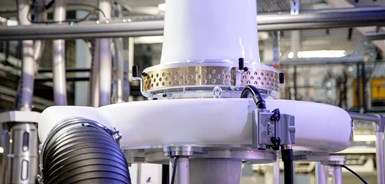High-Output Air Ring for Heavy-Duty Bags
Air ring exceeds output rates of 1320 lb/hr and targets bags for form-fill-seal applications.
The Ultra Cool 2.0 FFS air ring from Reifenhäuser Blown Film is said to achieve output rates of more than 1320 lb/hr. The air ring is billed as ideal for heavy-duty form-fill-seal (FFS) bags. Reifenhäuser says the output rates generated by its air ring results from high-precision, flow-optimized components and top the industry standard by up to 220 lb/hr.
EVO Ultra Cool 2.0 FFS is said to be suited for all typical film formulations and applications (consumer goods, industry, agriculture, etc.) while offering operator friendliness and high uptime. In testing, Reifenhäuser says film produced on blown film lines equipped with the air ring have outstanding mechanical film properties and thickness tolerances. This greatly simplifies processes to convert the film on printing and filling machines. The air ring also enhances production of fils containing recycled materials.

Photo: Reifenhäuser
Th new product is part of Reifenhäuser’s line of EVO FFS blown film systems, which include EVO extruders and die heads that provide optimized melt quality at very low melt temperatures.
Related Content
-
Use Interactive Production Scheduling to Improve Your Plant's Efficiencies
When evaluating ERP solutions, consider the power of interactive production scheduling to effectively plan and allocate primary and secondary equipment, materials and resources on the overall production capacity of the business and conclude that this is a key area that cannot be overlooked.
-
What to Know About Your Materials When Choosing a Feeder
Feeder performance is crucial to operating extrusion and compounding lines. And consistent, reliable feeding depends in large part on selecting a feeder compatible with the materials and additives you intend to process. Follow these tips to analyze your feeder requirements.
-
Part 2 Medical Tubing: Use Simulation to Troubleshoot, Optimize Processing & Dies
Simulation can determine whether a die has regions of low shear rate and shear stress on the metal surface where the polymer would ultimately degrade, and can help processors design dies better suited for their projects.












